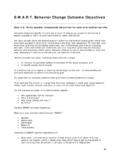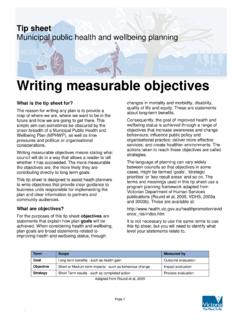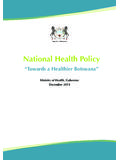Transcription of Table of Contents - TemplateZone
1 Table of Contents Chapter 1: Why Develop a Policy Manual?.. 3. Chapter 2: Getting 5. What is a Policy?.. 5. The Connection between Mission and Policy .. 5. policies 7. How to Start Creating Your Policy 8. Employment 9. Employment Status & 9. Employee Benefits .. 9. Payroll .. 9. Workplace Guidelines .. 9. Employee 9. E- policies .. 9. Preview the OPM Sections as a Primer .. 10. Organization Culture and 10. Get Support from Staff .. 10. The Role of Procedures and Forms .. 11. Chapter 3: Writing policies and the Approval Process .. 12. Write, Edit, Re-Write, Edit, Re-Write .. 12. Clarity, Conciseness, and 12. Write for Your Reader .. 13. Professional Writing Style .. 13. Make It Look Good .. 14. Review and Approval Process .. 15. Chapter 4: Distributing New policies .
2 16. Printed Manual .. 16. Electronic Distribution of policies .. 16. Training .. 17. Avoiding Policy 17. Chapter 5 Policy Manual for 18. Nonprofit 18. Board 18. Board Member 18. 18. About the OfficeReady Office Policy Manual .. 20. Department of Labor Posters .. 20. Poster 24. Job 27. 2. CHAPTER 1: WHY DEVELOP A POLICY MANUAL? Policy manuals are developed to help staff and management teams run the organization. In best use situations, policies play a strategic role in an organization. They are developed in light of the mission and objectives of the company and they become the media by which management's plans, rules, intents, and business processes become documented and communicated to all staff. Carefully drafted and standardized policies and procedures save the company countless hours of management time.
3 The consistent use and interpretation of such policies , in an evenhanded and fair manner, reduces management's concern about legal issues becoming legal problems. There is more about the legal aspects of policy later in this section. Policy manuals and their close relative the employee handbook should be an important part of the operation. They should be the first thing given to a new employee (either in hard copy of an electronic version). 1 They should also be easily accessible in their most up-to- date version. Hence it is extremely important that an organization's policies be a living document prepared and saved in Microsoft Word and easily exported into portable versions (like PDF) and made available over the company network.
4 Consider the benefits of written policies ; a set of written guidelines for human resource decisions. Better yet, think about the benefits of the process of developing policies . The process your company management team undergoes when comparing the policy alternatives, understanding their importance, and evaluating your company's current practices will help you to develop your company's guidelines and procedures that will make your organization a better run entity. Consider the benefits of better communication within your organization. A policy manual is a means of communication with employees; it is first a way to communicate to employees the management rules and guidelines of the organization. Employees want and need that type of guidance in black and white.
5 In addition, policies help to organize and announce management's plans for growth, and they communicate the company's investment in its employees by explaining employee benefits and workplace issues. 1. OfficeReady Office Policy Manual has a PDF conversion capability. This means that you can easily convert your policy manual or employee handbook into a PDF document for electronic distribution via e-mail or web site downloads. PDF (Portable Document Format) was created by Adobe as a standard way to view documents regardless of what software or hardware platform the reader is working with. PDF has quickly become an Internet default - documents on web pages are often uploaded as PDF documents, which can be viewed from the browser window, using free Adobe Acrobat technology (Acrobat Reader).
6 3. As a company's policies are developed they become a framework for consistency and fairness. Polices define management's standards for making decisions on various personnel and organizational issues. Clearly defined procedures and standards, spawned from polices that are well thought out, express the company's intent to make consistent and evenhanded decisions. Not enough can be said about the value that comes from policy creation. It is true that policy can help an organization run at its most efficient and effective level. That alone may bring value through cost savings and additional revenue. However, if done correctly, policies can bring more value by accurately reflecting the company's philosophy of business and employee relations as they demonstrate your creativity in solving policy issues, the competitive position of the company in providing a variety of employee benefits, and respect and appreciation for human resource management.
7 This type of message can go a long way towards promoting staff loyalty and everyone knows that staff longevity is a valuable asset. There is also a legal aspect of policies . They are a means to protect the legal interests of a company. The company's policies and procedures in many ways define the rights and obligations of the employee and the company. The policy manual is an expression of the rules governing the employment relationship. Today, more than ever, a company must protect its rights within that relationship by adopting policies that are fair to both sides, clearly stated, and legally permissible. With regards to the legal aspects of policy creation there is one important caution. If your company's employees are represented by a labor union, any collective bargaining agreement (CBA) between you and the union will, in effect, serve as a policy manual with respect to employee issues covered by the CBA.
8 In this case, you may utilize a policy manual that covers non-union employees. A CBA may also limit your ability to modify your policy manual at will, requiring instead negotiation of matters covered by the CBA. 4. CHAPTER 2: GETTING STARTED. What is a Policy? Writing policies that are effective, enforceable, and accepted by management and employees is difficult. To develop good policies that enhance rather than hinder the chances of achieving organizational objectives , it helps to understand exactly what a policy is and how it relates to such concepts as mission, objectives and procedures. A policy is a predetermined course of action established as a guide toward accepted objectives and strategies of the organization. Consider this excerpt from a policy development book: A vision is formulated, business processes are analyzed, and policy and procedure systems to support the vision are born.
9 As policies and procedures are written, approved, published, and implemented, the company's vision is articulated. 2. A first step in writing policies is agreeing on what a policy is and how it differs from a procedure. The two terms are often used interchangeably, but they are a bit different. Simply stated, a policy lays out what management wants employees to do, and a procedure describes how it should be done. 3 Procedures describe exactly how to carry out the policy and contain much more detail. The Connection between Mission and Policy Without policies boundaries and baselines related to the company's missions and objectives would not exist. When developing your policies , you should start with your mission and objectives . A mission statement should be a clear statement about who your company is trying to serve.
10 It should be a cultural reflection of the values, beliefs, and philosophy of the organization. 4 It should be very brief and very clear so that everyone in the organization can understand it and so that objectives are seen clearly as steps to achieving the mission. Here's the mission statement for Southwest Airlines: Southwest Airlines Company is the nation's low-fare, high customer satisfaction airline. We primarily serve short-haul city pairs, providing single-class air transportation, which targets the business commuter as well as leisure travelers. 2. Page, Stephen, B., p. 2. Establishing a System of policies and Procedures, Process Improvement Publishing, 2002. 3. McQuate, Craig , Penning Effective policies , Security Management, Dec 2002.





